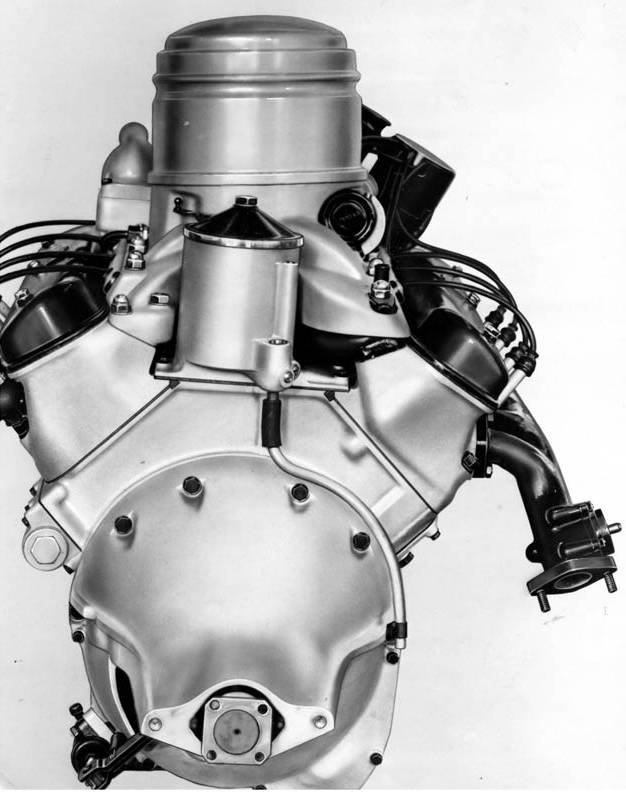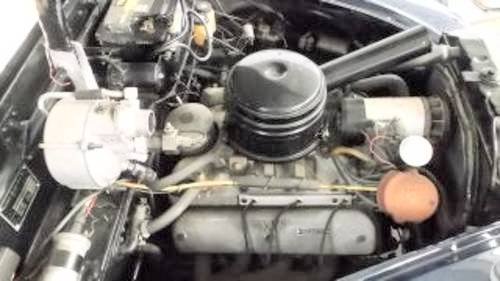BMW OHV V8 engine
| 1954 to 1965 | |
|---|---|
 |
|
| Overview | |
| Manufacturer | BMW |
| Production | 1954–1965 |
| Combustion chamber | |
| Configuration | OHV V8, 16 valves |
| Displacement | 2.6 L: 2,580 cc (157 cu in) 3.2 L: 3,168 cc (193.3 cu in) |
| Cylinder bore | 2.6 L: 74 mm (2.9 in) 3.2 L: 82 mm (3.2 in) |
| Piston stroke | 75 mm (3.0 in) |
| Cylinder block alloy | aluminium alloy with cast iron cylinder liners |
| Cylinder head alloy | aluminium alloy |
| Valvetrain | OHV |
| Combustion | |
| Fuel type | petrol |
| Cooling system | liquid cooled |
The BMW OHV V8 engine was the first V8 engine made by BMW. As engines M502,M506,M507,M532,M533 and M534.
This engine is usually named by the fact that it was the only pushrod-driven overhead valve V8 ever produced by BMW. All subsequent BMW V8 engines would use double overhead camshafts and fuel injection, but the development of the next V8 engine by BMW would not take place for more than three and a half decades.
Introduction
The BMW 501 was the first car made by BMW after World War II. Upon its introduction in 1951, it was the largest and heaviest car BMW had made. It was powered by a straight-6 engine based on a pre-war design, and though power was increased to 65 horsepower (48 kW), it was a sluggish performer. Their primary competitor, Mercedes-Benz, fielded the W187 in the same class but with superior performance.
Alfred Böning, BMW's chief engineer at the time, realized that the 501's engine would not be powerful enough. He got permission to design a new, larger engine for the 501, and began the design and development of the V8 engine. The design was finalized by Fritz Fiedler when he returned to BMW in 1952.
In order to reassert their status as the producer of sporty sedans, BMW debuted a version of the 501 sedan with a V8 engine. This was called the BMW 502. This V8 engine was available in 2.6 L (157 in3) and 3.2 L (193 in3) form.
Details and specifications
The engine was an aluminum alloy, longitudinally-mounted 90° V8 with cast iron wet liners and stiffening webs between the cylinders. Apart from the materials, the engine was similar in overall design to Cadillac and Oldsmobile V-8 designs from the late 1940s, with a central camshaft using pushrods to operating overhead valves in crossflow cylinder heads with wedge-shaped combustion chambers. The original version had a 74.0 millimetres (2.91 in) bore and a 75.0 millimetres (2.95 in) stroke, giving a displacement of 2,580 cubic centimetres (157 cu in) and a power output of 100 horsepower (75 kW; 100 PS) with a two barrel Solex 30 PAAJ carburettor and a compression ratio of 7.0:1.
A larger version was introduced in 1955; the bore was increased to 82.0 millimetres (3.23 in), resulting in a displacement of 3,168 cubic centimetres (193.3 cu in). The larger engine initially produced 120 horsepower (89 kW) with a single Zenith 32 mm carburetor and a compression ratio of 7.2:1, but was later available in higher states of tune, with power ratings reaching 160 horsepower (120 kW) in the 3200 S in 1961.
Models
| Engine | Displacement | Carburetors | Compression ratio | Power | Torque | Year |
|---|---|---|---|---|---|---|
| M502/1 | 2,580 cc (157 cu in) | Solex 30 PAAJ x 1 | 7.0:1 | 100 bhp (75 kW; 101 PS) at 4800 rpm | 184 N·m (136 lb·ft) @ 2500 rpm | 1954–1961 |
| M502/1 | Solex 30 PAAJ x 1 | 7.0:1 | 95 bhp (71 kW; 96 PS) at 4800 rpm | 1955–1961 | ||
| M502/100 | Zenith 32 NDIX x 1 | 7.5:1 | 100 bhp (75 kW; 101 PS) at 4800 rpm | 185 N·m (136 lb·ft) @ 2500 rpm | 1961–1963 | |
| M502/110 | Zenith 32 NDIX x 1 | 7.5:1 | 110 bhp (82 kW; 112 PS) at 4900 rpm | 186 N·m (137 lb·ft) @ 3000 rpm | 1961–1963 | |
| M533 | Zenith 32 NDIX x 1 | 7.5:1 | 110 bhp (82 kW; 112 PS) at 4900 rpm | 186 N·m (137 lb·ft) @ 3000 rpm | 1963 | |
| M506/1 | 3,168 cc (193 cu in) | Zenith 32 NDIX x 1 | 7.2:1 | 120 bhp (89 kW; 122 PS) at 4900 rpm | 214 N·m (158 lb·ft) @ 2500 rpm | 1955-1961 |
| M506/140 | Zenith 36 NDIX x 1 | 9.0:1 | 140 bhp (104 kW; 142 PS) at 5400 rpm | 242 N·m (178 lb·ft) @ 3000 rpm | 1961-1963 | |
| M534 | Zenith 36 NDIX x 1 | 9.0:1 | 140 bhp (104 kW; 142 PS) at 5400 rpm | 242 N·m (178 lb·ft) @ 3000 rpm | 1963-1965 | |
| M503/1 | Zenith 32 NDIX x 2 | 7.3:1 | 140 bhp (104 kW; 142 PS) at 4800 rpm | 220 N·m (162 lb·ft) @ 3800 rpm | 1956-1961 | |
| M503/160 | Zenith 36 NDIX x 2 | 9.0:1 | 160 bhp (119 kW; 162 PS) at 5600 rpm | 245 N·m (181 lb·ft) @ 3600 rpm | 1961-1963 | |
| M532 | Zenith 36 NDIX x 2 | 9.0:1 | 160 bhp (119 kW; 162 PS) at 5600 rpm | 245 N·m (181 lb·ft) @ 3600 rpm | 1963 | |
| M507/1 | Zenith 32 NDIX x 2 | 7.8:1 | 150 bhp (112 kW; 152 PS) at 5000 rpm | 240 N·m (177 lb·ft) @ 4000 rpm | 1956-1959 |
M502/1
The original 2.6 L version of the engine was developed for the BMW 502 and was introduced with it in 1954. A 95 horsepower (71 kW; 96 PS) version of this engine was available in the 501 V8 of 1955. In 1958, the 501 V8 and 502 were renamed the 2.6 and 2.6 Luxus respectively, with no changes in engine specification.
Applications:
- 1954-1958 BMW 502
- 1955-1958 BMW 501 V8
- 1958-1961 BMW 2.6
- 1958-1961 BMW 2.6 Luxus
M502/100 and M502/110
In the summer of 1961, the 2.6 L engines were uprated with the Zenith 32 NDIX carburetor from the earlier 3.2 L engines and a 7.5:1 compression ratio. With this upgrade, the 2.6 became the 100 horsepower (75 kW; 100 PS) 2600 and the 2.6 Luxus became the 100 horsepower (75 kW; 100 PS) 2600 L. These cars continued in production until December 1963
Applications:
- 1961-1963 BMW 2600
- 1961-1963 BMW 2600L
M533
M533 is version of M502/110 with gearbox directly mounted to engine.
Applications:
- 1963 BMW 2600L
M506/1
The 3.2 L engine was developed in 1956, and was offered in the 502-based 3.2 from then until 1961.
Applications:
- 1955-1961 BMW 502 3.2
M503/1 and M507/1
BMW's V8 sports models, the 503 and 507, used M503/1 and M507/1 engines respectively, each with a pair of Zenith 32 NDIX two-barrel carburetors. With these, and a compression ratio of 7.5:1, the 503's engine produced 140 horsepower (100 kW) at 5000 rpm. The tuning of the 507's engine went further, with high-lift cams, a different spark advance curve, polished combustion chamber surfaces, and a compression ratio of 7.8:1, producing 150 horsepower (110 kW; 150 PS) at 5000 rpm. Both models were discontinued in March 1959.
The two-carburetor engine from the 503 was used in the 502-based 3.2 Super from 1957 to 1961.
Applications:
- 1956-1960 BMW 503
- 1956-1959 BMW 507
- 1957-1961 BMW 3.2 Super
M506/140 and M503/160
The single-carburetor 3.2 and two-carburetor 3.2 Super were replaced in 1961 with the M506/140 (140 horsepower (100 kW)) for 3200 L and the M503/160 (160 horsepower (120 kW)) for 3200 S respectively.The increase in power came from larger Zenith 36 NDIX carburetors and a compression ratio of 9.0:1
Production of V8 sedans ended in 1963, but the engine from the 3200 S was used in the 3200 CS coupé from January 1962 to September 1965.
Applications:
- 1961-1963 BMW 3200 L
- 1961-1963 BMW 3200 S
- 1961-1963 BMW 3200 CS
M532 and M534
M532 and M534 were replacement for M503/160 and M506/140 with gearbox directly mounted to engine.
Applications:
- 1963 BMW 3200 L
- 1963 BMW 3200 S
- 1963-1965 BMW 3200 CS
Use by other manufacturers
Frazer-Nash Continental
Frazer-Nash, which had been an importer of BMW cars into the United Kingdom, used the BMW V8 in a limited run of cars named Continental. The Continental was available with either engine size, and was the last motor car Frazer-Nash made.
Talbot-Lago America
Due to financial troubles, Talbot-Lago ceased production of engines of their own design, and instead relied on BMW V8 engines.
BMW OHV V8 engine in the 502
Technical
-
BMW OHV V8 engine Technical details and specifications (1954-1965)
M532 and M534 BMW 3200 CS (1962-1965)
ENGINE:front, 4 stroke
cylinders: 8, Vee-slanted at 900
bore and stroke: 3.23 x 2.95 in, 82 x 75 mm
engine capacity: 193.75 cu in, 3168 cu cm
compression ratio: 9 : 1
cylinder block: light alloy, wet liners
cylinder head: light alloy
crankshaft bearings: 5
valves: 2 per cylinder, overhead, in line, with push rods and rockers camshaft: 1, at centre of Vee
lubrication: gear pump, full flow filter, oil cooler
carburation: 2 Solex 34 PAJTA twin barrel downdraft carburettors
fuel feed: mechanical pump
cooling system: water© Motor car History

